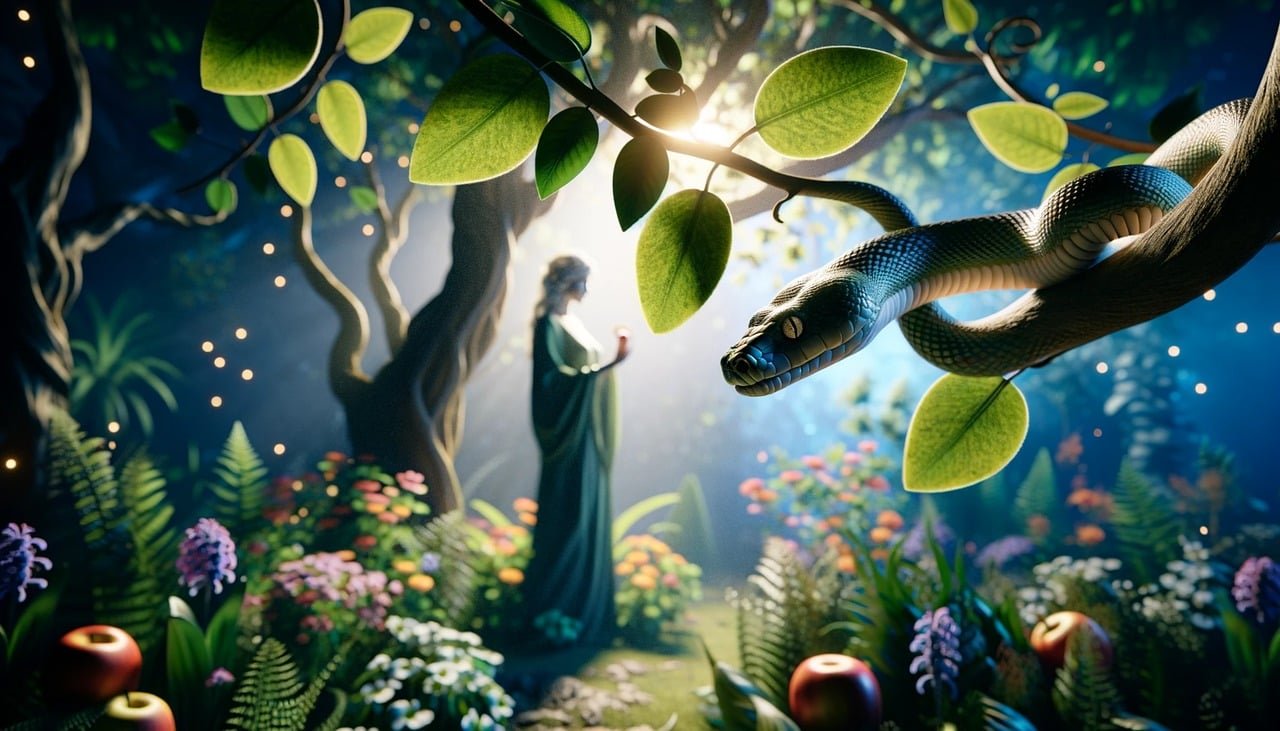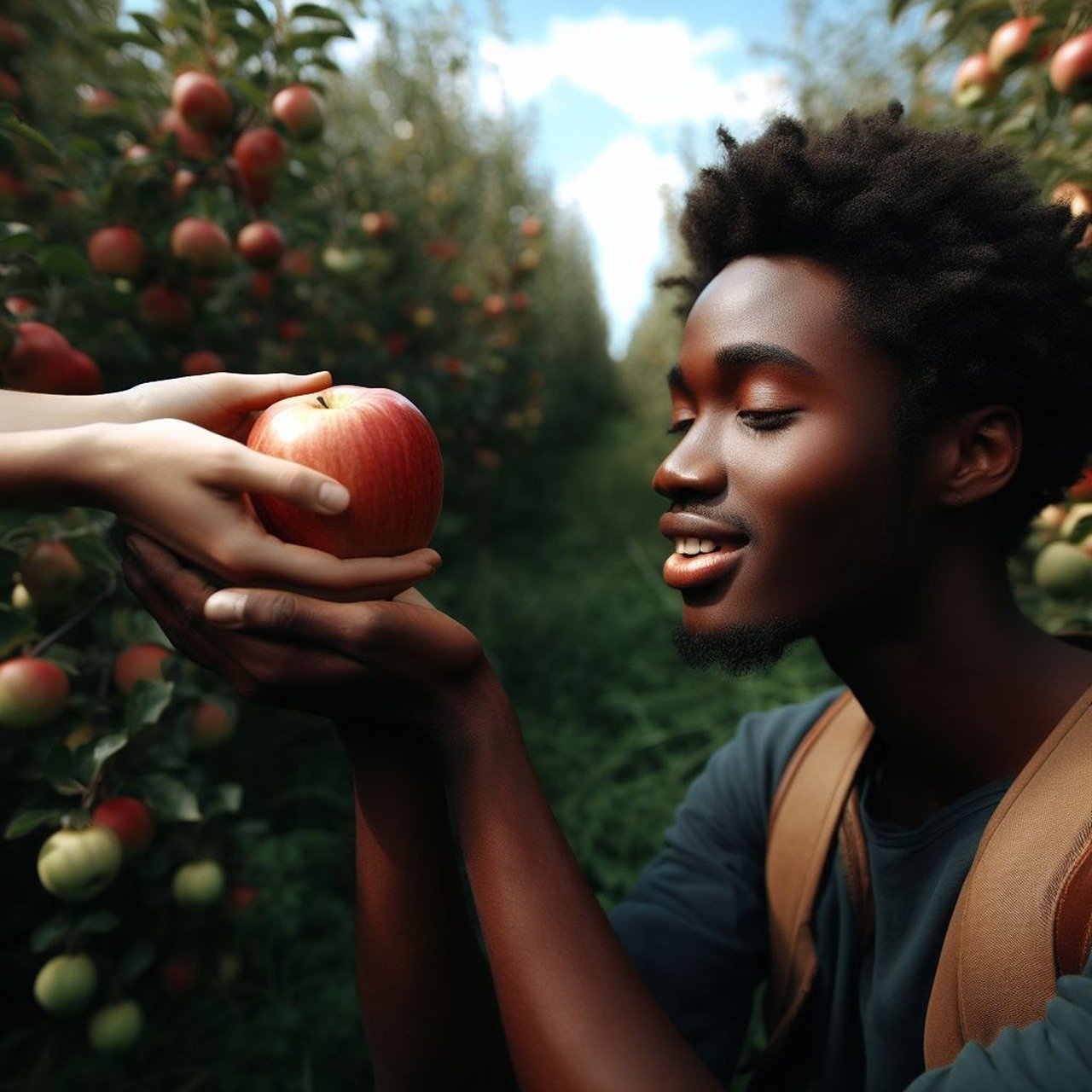Week 1: Eve – The First Woman
Genesis 2:18-25; Genesis 3

Rediscovering Eve: A Journey Through History and Myth
In the annals of human history, there exists a figure who transcends time and myth—a woman named Eve, cast as the first of her kind, born from Adam’s rib in the Garden of Eden. As a modern woman delving into the depths of ancient texts and scientific inquiry, I embark on a thorough investigation of Eve’s life, exploring her creation, her temptation, and the enduring impact of her choices on humanity.
The Creation of Eve: A Divine Genesis
Imagine the scene: Eden, a paradise lush with life and wonder, where every flower bloomed with hues unseen before, and every creature moved with grace and innocence. Here, in this utopia, God fashioned Eve—an equal to Adam, but distinct in her creation. Eve was not formed from the dust of the ground like Adam; instead, she emerged from Adam’s rib, symbolizing her unity and partnership with him (Genesis 2:22).
As Eve opened her eyes for the first time, surrounded by the breathtaking beauty of Eden, she must have felt a surge of curiosity and wonder. How did she perceive her purpose? As the first woman, her very existence was imbued with divine intent—to complement Adam, to walk alongside him in harmony, and together, to tend to the garden and nurture the creatures entrusted to their care.
In her innocence, Eve knew no shame, no fear. She experienced a profound connection with her Creator, God, who walked with them in the cool of the day (Genesis 3:8). Eden was not merely a physical paradise but a place of spiritual communion where Eve delighted in the presence of God and the perfection of His creation.
Genesis 2:25 paints a picture of their innocence and unity: “And the man and his wife were both naked and were not ashamed.” This verse signifies not just physical nakedness but a state of pure transparency and trust between Adam, Eve, and God. There was no need for shame or fear because their hearts were aligned with God’s perfect will.
Eve’s role extended beyond mere companionship with Adam. She shared in the stewardship of Eden, naming the animals alongside Adam and participating in the cultivation of the garden (Genesis 2:19-20). Imagine Eve’s delight as she discovered each creature’s unique characteristics and marveled at the diversity of life around her. Her days were filled with wonder and purpose, each moment a testament to the Creator’s wisdom and creativity.
In this pristine environment, Eve flourished as a woman created in God’s image, embodying qualities of compassion, intelligence, and creativity. Her interactions with Adam were marked by mutual respect and love, reflecting the divine intention for partnership and unity within marriage (Genesis 2:23).
As Eve walked through Eden, she must have felt a profound sense of responsibility and privilege. She was entrusted with caring for God’s creation, ensuring its harmony and flourishing. Every day brought new discoveries and joys, deepening her understanding of God’s love and provision.
Eve’s early days in Eden were characterized by innocence, wonder, and purpose. She lived in perfect harmony with God, Adam, and creation, embracing her role as the first woman with grace and wisdom. Her story in Genesis chapters 2 and 3 is a testament to God’s intention for humanity—to live in communion with Him, in harmony with one another, and as stewards of His creation. Eve’s journey begins here, in the garden of Eden, where her life and purpose unfolded according to God’s divine plan.
The Temptation and Fall: A Choice That Echoes Through Eternity

Paradise was not without its challenges. Enter the serpent—a cunning and beguiling creature, questioning the boundaries set by God. Eve, surrounded by the lush beauty of Eden, suddenly confronted by this serpent’s silver tongue, questioning the commandment regarding the tree of knowledge. In that moment, temptation coiled around her heart, promising wisdom and insight beyond her current understanding (Genesis 3:1-6).
What thoughts raced through Eve’s mind as she considered the forbidden fruit? Did she wrestle with doubt, curiosity, or a desire for greater knowledge? In her inner dialogue, she grappled with the weight of her choice—to defy God’s command and taste the fruit that promised enlightenment. Adam stood beside her, equally responsible, their fates intertwined in this pivotal moment (Genesis 3:6).
God had given clear instructions to Adam regarding the tree of the knowledge of good and evil: “You may surely eat of every tree of the garden, but of the tree of the knowledge of good and evil you shall not eat, for in the day that you eat of it you shall surely die” (Genesis 2:16-17). This commandment was meant to safeguard their relationship with God and protect them from the consequences of disobeying His will.
The serpent, however, craftily questioned God’s authority and motives, sowing seeds of doubt in Eve’s heart. He enticed her with the allure of knowledge and power, suggesting that eating the forbidden fruit would make her like God, knowing good and evil (Genesis 3:5).
As Eve succumbed to temptation and ate the fruit, her eyes were opened to a new reality—awareness of their nakedness and the onset of shame (Genesis 3:7). Eden, once their haven, became a place of exile as they faced the immediate consequences of their disobedience. Each participant in this tragic event faced specific curses from God:
- To the Serpent: God cursed the serpent, condemning it to crawl on its belly and eat dust all the days of its life. He also prophesied enmity between the serpent and Eve’s offspring, ultimately foretelling the defeat of the serpent by the Seed of the woman (Genesis 3:14-15).
- To Eve: God pronounced specific consequences for Eve, including increased pain in childbirth and a desire for her husband, coupled with a new dynamic where he would rule over her (Genesis 3:16).
- To Adam: God cursed the ground because of Adam’s disobedience, making it produce thorns and thistles and requiring Adam to toil for his food through hard labor (Genesis 3:17-19).
These curses underscored the gravity of their actions and the far-reaching implications of their disobedience. They were now subject to mortality, pain, and hardship—realities that would shape the human experience for generations to come.
Cherubim were placed at the entrance to the garden, guarding the way to the tree of life, symbolizing humanity’s expulsion from Eden and the loss of access to eternal life in their fallen state (Genesis 3:24). This marked the beginning of humanity’s journey through sin and its consequences, a journey that would ultimately find its redemption in the promise of a Savior—a descendant of Eve—who would crush the serpent’s head and restore humanity’s broken relationship with God (Genesis 3:15).
Eve’s decision, born from curiosity and desire for knowledge, set in motion a chain of events that shaped human history and underscored the complexities of human nature—our capacity for both obedience and disobedience, and the enduring need for redemption and restoration through God’s grace. Her story serves as a poignant reminder of the consequences of sin and the hope found in God’s promise of salvation through Jesus Christ.
Eve’s Legacy: From Mitochondrial Eve to Cultural Icon

Eve’s story transcends biblical narrative—it intertwines with scientific inquiry through the concept of Mitochondrial Eve. In genetic studies, Mitochondrial Eve represents the most recent common matrilineal ancestor of all living humans, tracing back to a single woman in ancient times. This scientific hypothesis aligns with the biblical account of Eve as the mother of all living (Genesis 3:20).
Contrary to misconceptions, Eve was not merely the mother of Cain and Abel. Scripture reveals she bore Seth and likely other sons and daughters, establishing the lineage of humanity (Genesis 5:4). The question of Cain’s wife is contextualized within the early human genealogy, where intermarriage among close relatives was permissible before Mosaic laws (Genesis 4:17).
Reflections on Eve: Lessons of Curiosity, Choice, and Redemption
As I reflect on Eve’s journey through the lens of a modern woman, I am struck by the complexity of her narrative. Eve’s story is not just a tale of temptation and fall but a profound exploration of human nature—our desires, choices, and their far-reaching consequences. Through her, we witness the enduring grace of God and His redemptive plan for humanity, fulfilled ultimately in Christ’s sacrifice on the cross.
Eve’s legacy persists as a testament to resilience, forgiveness, and the inherent dignity of every human soul. Her story challenges us to examine our own choices, confront our temptations, and embrace the promise of redemption that echoes through the ages. As I conclude this journey into Eve’s world, I am reminded of her pivotal role in shaping humanity’s narrative—an enduring symbol of courage, curiosity, and the enduring quest for knowledge and grace.
References
- Holy Bible, Genesis 2-5
- Scientific studies on Mitochondrial Eve
- Cultural interpretations and myths surrounding Eve












9 thoughts on “Women of the Bible Series: Rediscovering Eve”
Eve damned us
Great read
This post really helped me understand Eve beyond just the fall. She was the first mother, the first woman to walk with God—so much depth to her story!
We always blame Eve, but Adam made a choice too! This gave me a new perspective on her role in the bigger picture.
This post really made me rethink Eve’s story. Instead of just seeing her as the one who messed up, I see her as a woman who had to learn, grow, and keep moving forward, just like we all do.
Eve’s story is so much deeper than just the fall—she was the first woman, the mother of all, and her journey shaped everything. I love how this post gives her more dimension!
I never realized how much we can learn from Eve’s story. It’s about being strong even when things don’t go as planned.
Miss girl was so busy in the beginning, but we can’t blame everything on her because we are not perfect either
The way things are going in the country right now is crazy just knowing that all these things started with Eve